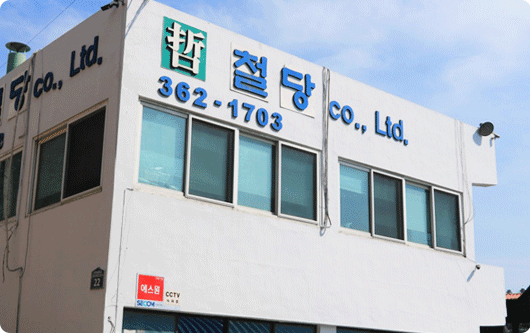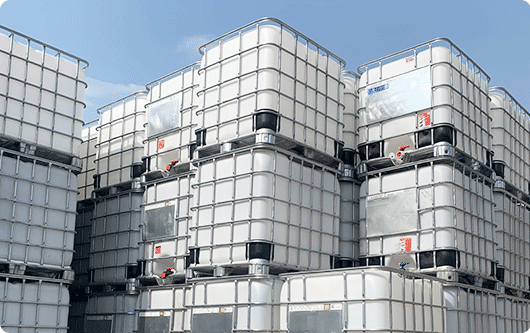친환경 드럼의 모든것!
철당(주)에 오신것을
진심으로 환영합니다!
네이버 스마트스토어!
스마트스토어 에서도
저희 제품을 확인하세요
제품 구매하기
제품소개
Product
철당에서 제공하는 제품을 소개합니다


회사소개
Company
간단한 회사소개 및 허가보유 사항입니다
ABOUT US
철당(주)는 1960년대부터 창립되어 현재까지 지정폐기물과 일반폐기물을 철저하게 처리함으로써 환경오염을 방지하고 자연보호에 앞서고 있습니다.
환경부 지정폐기물인 폐 ibc탱크,폐 드럼(철,pe,open드럼)을 폐기물 관리법에 따라 회수하고 세척재생하여 판매하는 재활용 포장용기 전문회사입니다.
License
십수년간 쌓아온 노하우와 최근 자동화설비를 설치하여 포장업체의 신관 대체 사용으로 인한 원가절감 및 부족한 자원을 재활용하는데 일조하고있습니다. 귀사에서 사용 후 발생된 폐 ibc탱크, 폐 드럼의 처리 및 신관대치용 재생 ibc탱크, 재생드럼에 대해 문의하여 주시면 성심껏 상담해드리겠습니다.
VIEW MORE
오시는길
LOCATION
철당(주)의 방문하실 고객님들을 위한
정보입니다

ADDRESS
경남 양산시 산막공단 북2길 22

E-MAIL
kdi1703@naver.com

KAKAO
cheoldang

TEL
055-362-1703
TOP
IBC탱크
IBC탱크 란? Intermediate Bulk Container Tank의 약어로써 컨테이너에 선적이 용이하도록 제작된 용기를 말합니다. IBC TANK의 경우 고체과 액체 위험물을 운송, 운반하는데 적합합니다. IBC탱크는 고압가스를 운송, 운반에는 적합하지 않습니다. IBC TANK는 지게차로 이동이 가능하며, 재사용이 가능한 장점이 있다.
1. IBC탱크 전통적인 재료
· 플라스틱 (고밀도 폴리에틸렌, HDPE)
· 합성물 : 아연 도금 강철 및 플라스틱
· 탄소강
· 스테인리스 스틸 (304 및 316 / 316L 등급)
1) 고밀도 폴리에틸렌(HDPE) IBC - CLASS II/III 적용
많은 일반적인 산업 화학 물질, 산, 알칼리, 불활성 제품, 제품 상품, 제조 중간체 및 물, 산, 염기, 염, 비료의 물 / 용액 적용에 대한 전반적으로 우수한 내성. HDPE IBC는 다양한 화학 물질 및 재료에 민감합니다. 호환성 확인을위한 예방 조치가 필요한 화학 물질의 예로는 알코올, 글리콜, 강산 화제, 저 분자량 탄화수소, 오일, 그리스 등이 있습니다.
2) 탄소강 IBC - CLASS I 적용
탄소강 금속의 강도 및 내 화학성, 내구성 및 오래 지속되며 많은 화학 물질 및 용제, 알코올, 연료 유, 유압유, 일부 식용유, 석유 산업 화학 제품 / 제품에 적합합니다. 탄소강은 강산, 일부 강알칼리, 할로겐화 화합물, 이온 수용액, 강산 화제 및 일반 물과의 비 호환성을 나타낼 수 있으며, 탈 이온화되지 않은 경우 권장되지 않습니다.
3) 스테인리스 강 IBC - CLASS I 적용
긴 서비스 재료, 탱크 수명 및 최고의 위생 표준을 경험하는 상당한 내 화학성 및 호환성. 스테인레스 스틸은 식품 산업 재료, 와인 및 음료 응용 프로그램 및 기타 소모품 또는 제품 중간체에 자주 사용됩니다. 또한 탄소강이 민감하게 반응하는 많은 산 ( 특히 유기물 ) 및 염기 뿐만 아니라 재료 저항성이 증가하여 화학, 석유 화학 및 제약 산업에서 많이 활용 됩니다. 스테인리스 강은 특정 강산 ( 무기, 주로 ) 및 할로겐 화합물과의 비 호환성을 나타 냅니다.
2. IBC TANK 사용 물질
· 위험 물질 또는 위험물을 포함한 벌크 화학 물질
· 산업 생산에 사용되는 상품 및 원자재
· 액체, 과립 및 분말 식품 성분
· 옥수수 시럽, 메이플 시럽 또는 당밀 과 같은 식품 시럽
· 석유 화학 등 제품, 석유 , 가스 , 용제 , 세제 , 또는 접착제
· 빗물 에 사용하는 경우 옥상 빗물 collectionbatch의 제품
· 페인트 및 산업용 코팅
· 제약 화합물, 성분, 중간체, 배치 제품
· 의료 관련 품목, 고형 상품, 바이오 폐기물 , 폐기물
· 포도원, 와인 발효, 증류주 생산
· 농업, 종묘장, 온실 사용 및 화학 물질
· 산업 부문에 걸친 많은 물, 폐수, 공정 용수 응용
3. IBC탱크의 종류
1) 폴리 케이지 토트 (Poly Caged Totes)
복합 케이 지형 IBC 토트 는 주로 화학 산업, 용제, 산, 부식제, 세제, 농작물 화학 물질 및 식품 산업 성분을 포함하거나 운반하는 응용 분야에서 한 번만 사용하기위한 저렴한 옵션을 제공합니다. 케이지 IBC는물 저장 및 공급 응용 프로그램뿐만 아니라 불활성의 민감하지 않은 상품과 함께반복적으로 사용할수 있습니다.
2) 플라스틱 IBC (All Plastic IBCs)
폴리에틸렌 (HDPE) IBC 탱크는 1/2 인치 두께의 플라스틱으로 회전 성형됩니다. 이 IBC 유형은 내구성이 매우 뛰어나고 재사용이 가능하며 부식 및 기타 화학적 공격에 대한 내성이 뛰어납니다. HDPE IBC는 화학 물질, 석유 제품, 물 및 일반 유해, 비유 해 물질과 관련된 작업에 매우 적합합니다. 엑스 칼리버 토트 는 일반적인 폴리 케이지 IBC에 대한 현대적이고 내구성이 뛰어난 대안으로 선택적으로 설계된 플라스틱 IBC 모델입니다.
3) 금속 IBC 탱크 (Metal IBC Tanks)
금속 IBC탱크(탄소 및 스테인리스 강)는 평균 서비스 수명이 가장 긴 업계에서 가장 강력하고 내성이 가장 강한 IBC 모델입니다. 탄소강 IBC 유형은 화학 물질, 윤활유, 오일 및 용제에 널리 사용됩니다. 스테인리스 스틸 IBC 모델은 집중적 인 위생 기능으로 인해 식품, 음료, 포도원, 화장품 및 제약 산업에서 잘 사용됩니다. 금속 IBC는 내식성과 최대 Class I 가연성, 가연성 물질 저장에 대한 UL142 및 NFPA 30 인증 으로 인해 석유 및 가스 산업에서 광범위하게 사용됩니다.
4. IBC TANK의 안전장치
1) AIRVENT CAP 가스가 발생하는 액체용 IBC에 사용
2) CAP 가스가 발생하지 않는 일반 액체용 IBC에 사용
3) 정전기 제어 - 도전성의 중형 벌크 용기(IBCs)
· 도전성의 IBCs는 인화성의 위험 분위기가 존재하는 장소에서는 모든 작업 시 접지되어야 한다.
· 도전성 용기 및 도전성 부속장비의 접지를 유지
- 금속제 깔때기는 접지되어야 한다.
- 유연 충전관은 내부 보강전선을 포함한 모든 도전성 구성요소가 접지와 연결되어야 한다.
· 비도전성 물질을 접지된 IBCs로 이송하는 경우, 물질에 축적된 전하는 그대로 해 당 물질에 남는다. 정전기 이완과정은 해당 전하가 물질을 통과하여 용기 벽면의 반대 전하로 천천히 이동하는 것이다.
4) 정전기 제어 - 비도전성의 중형 벌크 용기(IBCs)
· 비도전성 IBCs로 물질을 이송하는 경우, 용기의 재질은 물질에 존재하는 정전하가 접지를 통하여 이완되는 것을 방해하며, 이 경우 도전성 물질도 전하를 축적할 수 있게 된다.
· 폭발성 분위기(가스, 인화성 증기, 가연성 분진 및 MIE가 10 mJ 미만인 하이브리드 혼합물 등)가 쉽게 생성되는 장소에서는 비도전성 IBCs를 충전하거나 비우지 말아야 한다.
· 인화성 액체가 존재하는 비도전성 용기 내부에 분말을 투입할 경우, 용기 내부는 밀폐시키고 불활성화 하여야 한다.
5) IRON CAG
· IBC TANK를 둘러싼 IRON CAGE가 외부 충격으로 부터 보호를 합니다.
· 탄소강 IBC, 스테인리스 강 IBC 금속재질의 경우 압력 환기 장치가 장착 된 경우 최소 30 분 동안 화재를 견딜 수 있습니다.
* 독일 Bundesanstalt für Materialforschung und -prüfung (BAM) 테스트 결과
6) IBC TANK 취급시 정전기 발생을 제어하기 위한 접지 모식도
5. IBC탱크의 표지
1) 철재 IBC 탱크 - CLASS II/III 적용
· 국내 위험물안전관리법에 의거 용기검사를 2년 6개월 마다 받아야함
· 기한 내 검사를 받지않으면 사법처리 됨
· 국제해상규정에 따른 표지 인정
· 철재탱크에는 좌측 사진의 표지판이 부착
2) 플라스틱 IBC 탱크 - CLASS I 적용
· 플라스틱 IBC TANK에는 스티커 형태의 지판이 부착
6.IBC탱크 부품
1) 알류미늄커플러
2) PP커플러
3) PE스마트커플러
4) 황동커플러(BRASS)
5) 스텐커플러(SUS304,316)
6) ibc탱크 부품
IBC버터플라이밸브(IBF-DN50*62mm,DN50*75mm)/IBC탱크용부속/IBC용부품/버터플라이밸브/IBC연결부품
IBC 볼밸브 DN50*75mm (EPDM,PTFE)/IBC탱크용부품/IBC연결부품/IBC부속/IBC연결부품
IBC 상부마개 155mm (밀폐형,통풍형)/IBC탱크용부품/IBC연결부품/IBC부속/IBC연결부품
IBC 탭(2"*20안나사*호스15A))/IBC탱크용부품/IBC연결부품/IBC부속/IBC연결부품
IBC HN커넥터(2"*15A,20A,25A)/IBC탱크용부품/IBC연결부품/IBC부속/IBC연결부품
IBC호스커넥터/2"*13파이~50파이 /IBC탱크용부품/IBC연결부품/IBC부속/IBC연결부품
IBC FM커넥터(2"*15A,20A,25A,40A,50A)/IBC탱크용/IBC탱크용부품/IBC연결부품/IBC부속/IBC연결부품
IBC FF커넥터(2"*40A,50A)//IBC탱크용부품/IBC연결부품/IBC부속/IBC연결부품
IBC캄록어댑터(2"*20A,25A,32A,40A,50A)/IBC탱크용부품/IBC연결부품/IBC부속/IBC연결부품
캄록커플링(PP)/어댑터엘보(E+C)/플라스틱어댑터/화학용어댑터/해수용어댑터/40A,50A
캄록커플링(PP)/호스생크엘보(C+호스)/화학용,해수용.40A,50A
캄록커플링(PP)/캄록레듀서(C+호스)/화학용커플링/해수용커플링/C50(2")*20,C50(2")*25,C50(2")*40
IBC 스파우트볼밸브(90도-15A,20A,25A,32A)/IBC탱크용 호스밸브/IBC탱크용부품/IBC연결부품/IBC부속/IBC연결부품
IBC 스파우트볼밸브(90도) HN커넥터세트(2"*15A,20A,25A)/IBC탱크용 호스밸브/IBC탱크용부품/IBC연결부품/IBC부속/IBC연결부품
IBC 스파우트(45도,2"*40A)/IBC탱크용부품/IBC연결부품/IBC부속/IBC연결부품
PVC수도가랑/15미리/15mm/화학용수도꼭지/화학용 밸브/IBC탱크용
PVC수도가랑/20미리/20mm/화학용수도꼭지/화학용 밸브/IBC탱크용
IBC 상부마개 155mm/IBC탱크용부품/IBC연결부품/IBC부속/IBC연결부품
#ibc탱크 #ibc #탱크 #ibctank #IBC탱크 #IBC #IBCTANK #중고ibc탱크 #1톤용기 #폐드럼
7. IBC탱크 종류
중고IBC탱크 600L PE 용기 농업용물탱크 벌크통 PE탱크 IBCTANK 세척
UN인증 IBC탱크 재생 [1톤 재생품 / UN인증 위험물 포장용기 / 위험물 화학용액 및 모든 액상 물질 / 화장품 원료 및 식품 가공 액상류]
중고IBC탱크 600L PE 용기 농업용물탱크 벌크통 PE탱크 IBCTANK 미세척
IBC 탱크 MF-ESD [1톤 새제품 / UN인증 위험물 포장용기(비중 GRAVITY 1.9) / 위험물 화학용액 및 모든 액상 물질 / 화장품 원료 및 식품 가공 액상류]
UN마크 1톤 IBC TANK PE 용기 농업용물탱크 벌크통 PE탱크 MF-Series
IBC 탱크 BF-ESD [1톤 새제품 / UN인증 위험물 포장용기(비중 GRAVITY 1.6) / 인화점60˚C 이하의 위험물질에 적합(IMDG4.1.2.1항 적용) / 위험물 화학용액]
UN마크 1톤 IBC TANK PE 용기 농업용물탱크 벌크통 PE탱크 MF-ESD
UN마크 1톤 IBC TANK PE용기 농업용물탱크 벌크통 PE탱크 RF-RB
UN마크 1톤 IBC TANK PE 용기 농업용물탱크 벌크통 PE탱크 BF-Series
일반형엘보 J-01 IBC탱크 1000리터 500리터
UN마크 1톤 IBC TANK PE 용기 농업용물탱크 벌크통 PE탱크 새제품
#ibc탱크 #ibc #탱크 #ibctank #IBC탱크 #IBC #IBCTANK #중고ibc탱크 #1톤용기 #폐드럼
IBC(Intermediate bulk container) TANK
Intermediate bulk containers (also known as IBC tank, IBC tote, IBC, or pallet tank) are industrial-grade containers engineered for the mass handling, transport, and storage of liquids, semi-solids, pastes, or solids. The two main categories of IBC tanks are flexible IBCs and rigid IBCs. Many IBCs are reused or repurposed.
Rigid IBCs are stackable, reusable, versatile containers made from metal, plastic, or a composite of the two, designed for forklift and pallet jack maneuverability. They can hold up to 3 cubic metres (793 US gal) and are used for the transport of both hazardous and non-hazardous materials. Flexible IBCs, typically made from heavy polymers, are designed for storing or transporting dry, flowable products like sand or fertilizer. The cubic shape of IBCs allows for efficient transport and storage, and they can be custom-made based on specific customer requirements. IBCs are often used for shipping, handling, and storage of bulk chemicals, food ingredients, petrochemical products, paints, pharmaceutical compounds, and more. These containers can be purchased new, rebottled, or washed, and can be tracked using bar code and RFID tracking systems. When used for flammable or combustible liquids, IBCs should be clearly labeled and stored properly for safety reasons.
Rigid IBC tanks
Rigid intermediate bulk containers are stackable, reusable, versatile containers with an integrated pallet base mount that provides forklift and/or pallet jack maneuverability. These containers can be made from metal, plastic, or a composite construction of the two materials. Rigid IBC design types are manufactured across a volume range that is in between that of standard shipping drums and intermodal tank containers, hence the title "intermediate“ bulk container. IBC totes are authorized per Title 49 CFR codes to be fabricated of a volume up to 3 cubic metres (793 US gal) while maintaining the "IBC" name and their federal shipping and handling permits.
IBC tank capacities generally used are often 1,040 and 1,250 litres (275 and 330 US gal). Intermediate bulk containers are standardized shipping containers often UN/DOT certified for the transport handling of hazardous and non-hazardous, packing group II and packing group III commodities. Many IBC totes are manufactured according to federal and NSF/ANSI regulations and mandates, and are often IMDG approved as well for domestic and maritime transport. Metal alloy IBC tanks are also manufactured according to NFPA and UL142 certification standards for extensive storage of materials labeled as flammable and/or combustible.
Intermediate bulk containers can be manufactured from various materials based on the requirements of the application or service the IBC will be used for. Traditional materials include:
- Plastic (high-density polyethylene)
- Composite: galvanized steel and plastic
- Carbon steel
- Stainless steel (304 and 316/316L grades)
The most widely utilized and known IBC is the limited re-use, caged IBC tote container. Caged IBC totes are composite intermediate bulk containers — a white/translucent plastic container (typically high-density polyethylene) contained and protected by a tubular galvanized steel grid, common. Caged IBC totes are commonly used due to their low cost, wide compatibility, and versatility.
Flexible IBC bags
A standard flexible intermediate bulk container can hold 500 to 1,000 kg (1,100 to 2,200 lb) and manufacturers offer bags with a volume of 285–2,830 litres (10–100 cu ft).
Flexible intermediate bulk containers are made of woven polyethylene or polypropylene or other heavy polymers. Bags, are designed for storing or transporting dry, flowable products, such as sand, fertilizer, and plastic granules. they typically have lifting straps but are frequently handled on a pallet.
Engineered design
Most IBCs are cube-shaped and this cube-shaped engineering contributes to the packaging, stacking, storing, shipping, and overall space efficiency of intermediate bulk containers. Rigid IBC totes feature integrated pallet bases with dimensions that are generally near the common pallet standard dimension of 1,200 mm × 1,000 mm or 48 in × 42 in (1,219 mm × 1,067 mm). IBC container’s pallet base is designed for universal maneuverability via forklift/pallet jack channels. Almost all rigid IBCs are designed so they can be stacked vertically one atop the other using a forklift. Most have a built-in tap (valve, spigot, or faucet) at the base of the container to which hoses can be attached, or through which the contents can be poured into smaller containers.
The most common IBC sizes of 275 and 330 US gallons fit on a single pallet of similar dimensions to pallets which hold 4 drums (220 US gallons), providing an extra 55-110 gallons of product in the IBC over drum storage, a 25%-50% increase for the same storage footprint. Additionally, IBCs can be manufactured to a customer's exact requirements in terms of capacity, dimensions, and material.
Advantages
There are many advantages to the engineering and design of the IBC model:
- Being cubic in form, they can transport more material in the same footprint compared to cylindrical-shaped containers, and far more than might be shipped in the same space compared to packaging in consumer quantities.
- Composite IBCs rely on plastic liners that can be filled and discharged with a variety of systems.
- The manufacturer/processor of a product can bulk package a product in one country and ship to many other countries at a reasonably low cost where it is subsequently packaged in final consumer form in accordance with the regulations of that country and in a form and language suitable for that country.
- High organization, mobility, integration capabilities.
- Increase logistic and handling timelines, efficiencies, and capacity through single container filling, moving, loading, transit, and dispensing.
- Potential long term assets given the durability of IBC construction materials.
- Provides a reliable and consistent way to handle or store materials.
Uses
IBCs are often used to ship, handle, and/or store:
- Bulk chemicals including hazardous materials or dangerous goods
- Commodities and raw materials used in industrial production
- Liquid, granulated, and powdered food ingredients
- Food syrups, such as corn syrup, maple syrup or molasses
- Petrochemical products, such as oil, gas, solvents, detergents, or adhesives
- Rainwater
- Used IBCs are the basic building blocks for many home aquaponic systems
- Paints and industrial coatings
- Pharmaceutical compounds, ingredients, intermediates, batch products
- Healthcare related items, solid commodities, bio-waste, waste materials
- Vineyards, wine fermentation, spirits production
- Agriculture, nursery, greenhouse uses and chemicals
- Many water, waste water, process water applications across industry sectors
- Used by land owners to support firefighting activities
Acquisition and disposal
Intermediate bulk containers may be purchased or leased. Bar code and RFID tracking systems are available with associated software.
An IBC can be purchased as a new unit (bottle and cage), a rebottled unit (new bottle and washed cage) or a washed unit (both bottles and cages have been washed). A washed unit is typically less expensive, with the new unit being the most expensive, and the rebottled unit near the mid-point. In many cases, a customer may purchase a mix (“blend”) of these types of units under a single price, to simplify the accounting.
The customer's choice of unit primarily depends on either actual or perceived sensitivity of their product to contamination, and the overall ability to clean their specific product type from the bottle. Those with a lower contamination risk are prime candidates for the washed units. With the exception of products produced in "clean rooms" (GMP - good manufacturing practices), the decision of a washed over a new is usually a matter of availability or appearance.
An IBC can be leased in a closed-loop (using only the IBCs which were used by a given customer and washed or rebottled) or the most common open-loop system (where the origin of the rebottled or wash unit is flexible). For plastic composite units, the trip lease[further explanation needed] has largely been replaced by a blended purchase. Single use flexible IBC's such as those used for aggregate transportation in the construction industry are a major source of plastic pollution. Most aggregate suppliers do not offer a scheme to refund a deposit upon return of empty IBC's & (in UK) they are frequently fly tipped & seen abandoned roadside.
Safety
When exposed to fire as in a warehouse event, plastic IBCs containing combustible or flammable liquids can melt or burn fairly rapidly, releasing their entire contents and increasing the fire hazard by the sudden addition of combustible fuel. Rigid plastic (as high-density polyethylene) IBCs that transport and house flammable/combustibles are recommended to have clear labeling and stored within properly secured structures and according to federal regulations, such as NFPA and OSHA. Metal IBCs (as carbon steel and stainless steel) are often approved per UL 142 requirements for housing these materials long term. Accordingly, metal IBC tanks can be used for Class I materials, while rigid plastic IBCs can be used for Class II/III materials.
Concerning the mechanical stability and sloshing of intermediate bulk containers during transport, some research has been performed through the U.S. Department of Transportation which seems to indicate that IBC containers perform overall very well during transit in terms of sloshing and mechanical stability.
For metal IBCs, test reports by the German Bundesanstalt für Materialforschung und -prüfung (BAM) show that a metal IBC can withstand fire for at least 30 minutes, if it is equipped with a pressure venting device.
#ibc탱크 #ibc #탱크 #ibctank #IBC탱크 #IBC #IBCTANK #중고ibc탱크 #1톤용기 #폐드럼





